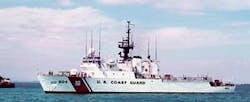By Ben Ames
PORTSMOUTH, Va. — As the only military-capable agency in the U.S. Department of Homeland Security, the U.S. Coast Guard is on the front lines of the fight against terrorists, yet the service is still using outdated, pre–Sept. 11 ships and aircraft, its leaders complain.
"The Service's current deepwater assets are aging and technologically obsolete. They lack essential speed, interoperability, and sensor and communication capabilities," declares the Coast Guard's Web site.
null
Enter Project Deepwater, a 20-year plan to upgrade and replace Coast Guard equipment. The project took its first steps forward this fall, as workers upgraded the communications network on the 270-foot medium-endurance cutter USCGS Northland (WMEC 904), and in the main land-based communications node for the East Coast.
Hurricane Isabel was beginning to batter the mid-Atlantic states as workers on Sept. 17 completed the upgrade to the Communication Area Master Station-Atlantic (CAMSLANT) in Chesapeake, Va.
They completed it before the storm, granting some Coast Guard ships high-speed access to the U.S. Department of Defense's Secret Internet Protocol Network (SIPRNET). Future enhancements will boost telecommunications abilities and let ships access the Coast Guard Command and Control (CGC2) Network.
Until now, Coast Guard staffers at sea have traded classified information solely by voice or recorded message traffic. But the SIPRNET access will let them use e-mail, says Ed Litwa, C4ISR program manager for ICGS is Integrated Coast Guard Systems (ICGS), a joint venture between Lockheed Martin and Northrop Grumman, with headquarters in Arlington, Va.
C4ISR stands for command, control, communications, computers, information, surveillance, and reconnaissance. ICGS won a competitive bid in June 2002 for the $11 billion, 20-year Deepwater project.
ICGS engineers completed an upgrade Nov. 3 of communications equipment aboard the Northland, based in Portsmouth, Va. The ship is the first Coast Guard cutter to use the new equipment, which includes SIPRNET access as well as twice its former data bandwidth.
On land, the West Coast data hub — Communication Area Master Station-Pacific at Point Reyes, Calif. — will get its upgrade in early 2004.
At dockside, ICGS workers will install upgrades in the Coast Guard's other ships, beginning with the entire fleet of 13 medium-endurance cutters. The next ship in line is the medium-endurance cutter USCGS Tampa (WMEC 902), located in Portsmouth, Va. They plan to complete that work within six months, and then build upgrades on nine 378-foot high-endurance cutters and 14 210-foot medium-endurance cutters.
At the end of the 20-year process of upgrades and replacements, the Coast Guard will have an entire new fleet, including:
- three classes of new cutters and their associated small boats;
- a new fixed-wing manned aircraft fleet;
- a combination of new and upgraded helicopters;
- cutter-based and land-based unmanned aerial vehicles (UAVs);
- C4ISR systems, and
- an integrated logistics regime.
Along the way, the plan calls for ICGS to upgrade 49 existing cutters and 93 helicopters, and acquire as many as 91 new ships, 35 fixed-wing aircraft, 34 helicopters, and 76 unmanned surveillance aircraft.
That is a thorny engineering challenge because ICGS planners have to ensure all those platforms will interoperate. They must guarantee that radios and computers will mesh, even as they upgrade some existing ships, and replace other ships with new designs.
To ensure a scalable and interoperable design, ICGS engineers are building the new communications systems almost exclusively with commercial off-the-shelf (COTS) components, Litwa says.
Aside from some unique items that DOD security planners require for the classified SIPRNET, it is all COTS — routers, switches, Web cache and content engines, laptops, and terminals. Using those common parts keeps the system flexible, Litwa says. That way, ICGS engineers can quickly upgrade cutter bandwidth from 64 to 128 kilobits per second as soon as INMARSAT satellites gain the capability.
For more information contact the Coast Guard and ICGS on-line at www.uscg.mil/deepwater and www.teamdeepwater.com.




